Applying polyurethane on the floor is one of the trickiest painting jobs out there. It requires selecting the best poly for floors. You need a lot of supplies and tools to get things done perfectly.
But as a beginner painter or craftsman, you need to be detailed about how to apply polyurethane to floors.
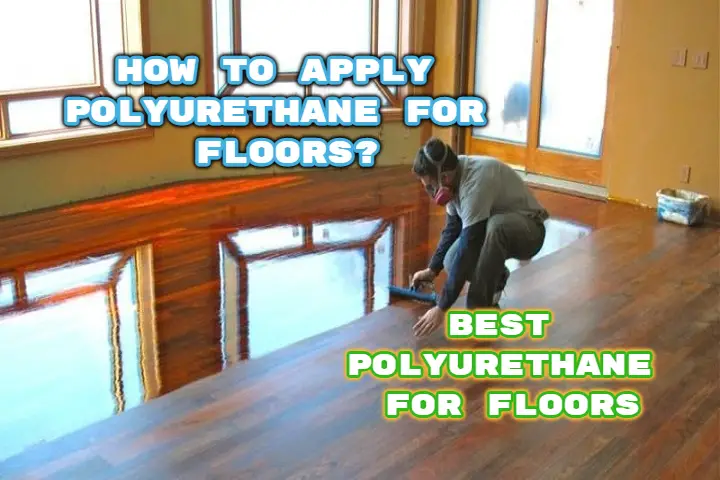
I did some research and here’s what I’ve found:
How to Apply Polyurethane for Floors?
Apply high-quality, durable Minwax Oil-Based Polyurethane to hardwood floors with a brush, allow it to dry within 12-24 hours, then lightly sand between coats for a smoother finish, applying up to three coats. After waiting for 72 hours to dry completely, you can walk on it.
Even veterans must be conversant with the best products to get on the market. This article comes in handy to help you do a perfect job on your floor. We’ll look at the issues and the frequently asked questions about applying poly on the floor.
Let’s jump in!
- How to Apply Polyurethane for Floors?
- What is Polyurethane Finish?
- Is Polyurethane Toxic after It Dries?
- Water-Based Polyurethane for Floors
- Oil-Based Polyurethane for Floors
- Water vs Oil-Based Polyurethane for Floors
- Types of Polyurethane Finish on Floors
- Do You Have to Sand between Coats of Polyurethane on Floors?
- How to Apply Polyurethane for Floors Step by Step?
- What to Consider Before Choosing Polyurethane for Floors
- Best Water-Based Polyurethane for Floors
- Minwax Water-Based, Oil-Modified Polyurethane Protective Wood Finish, Clear Satin
- Deft Interior Exterior Water-Based Polyurethane Finish Gloss, Quart
- RUST-OLEUM FBA 230031 Varathane Gallon Gloss Waterborne Diamond Floor Finish
- Bona Mega Semi-Gloss, Polyurethane Finish
- RUST-OLEUM 298273 Varathane Vara Gallon Semi-Gloss Water-Based Finish
- General Finishes High-Performance Water Based Topcoat, 1 Pint, Satin
- Minwax 13333 Clear Polycrylic Water-Based Protective Finish Satin
- Best Oil-Based Polyurethane for Hardwood Floors
- Minwax Fast-Drying Polyurethane Protective Wood Finish, Clear Satin, 1 Quart
- Rust-Oleum 9141H Oil-Based Ultimate Polyurethane, Quart, Satin Finish
- ZAR 33912 Oil-Based Polyurethane Wood Finish, QT, Clear
- RUST-OLEUM 130031 Varathane Gloss Oil Base Premium Polyurethane Floor Finish
- Watco 68041 Wipe-On Polyurethane Finish, Quart, Clear Gloss
- Old Masters 3576 Polyurethane Oil-Based Finish Gloss, 1 Quart, Clear
- General Finishes Arm-R-Seal Oil Based Topcoat, 1 Quart, Gloss
- How to Care for Polyurethane Wood Floors?
- Alternatives to Polyurethane
- Final Words: What is the best way to apply polyurethane to a floor?
What is Polyurethane Finish?
Polyurethane is a formulation of synthetic resin used in the finishing processes of wood. It is often chosen for its beautiful finish and clarity and provides a hard protective layer against scratch, statins, and liquids. It uses either water or oil as the base for the formulation to be mixed.
Depending on one’s preference, sheen options vary from matte to satin and semi-gloss to high gloss. Water-based polyurethane is popular because it has a lower odor and toxicity level than oil-based polyurethane.
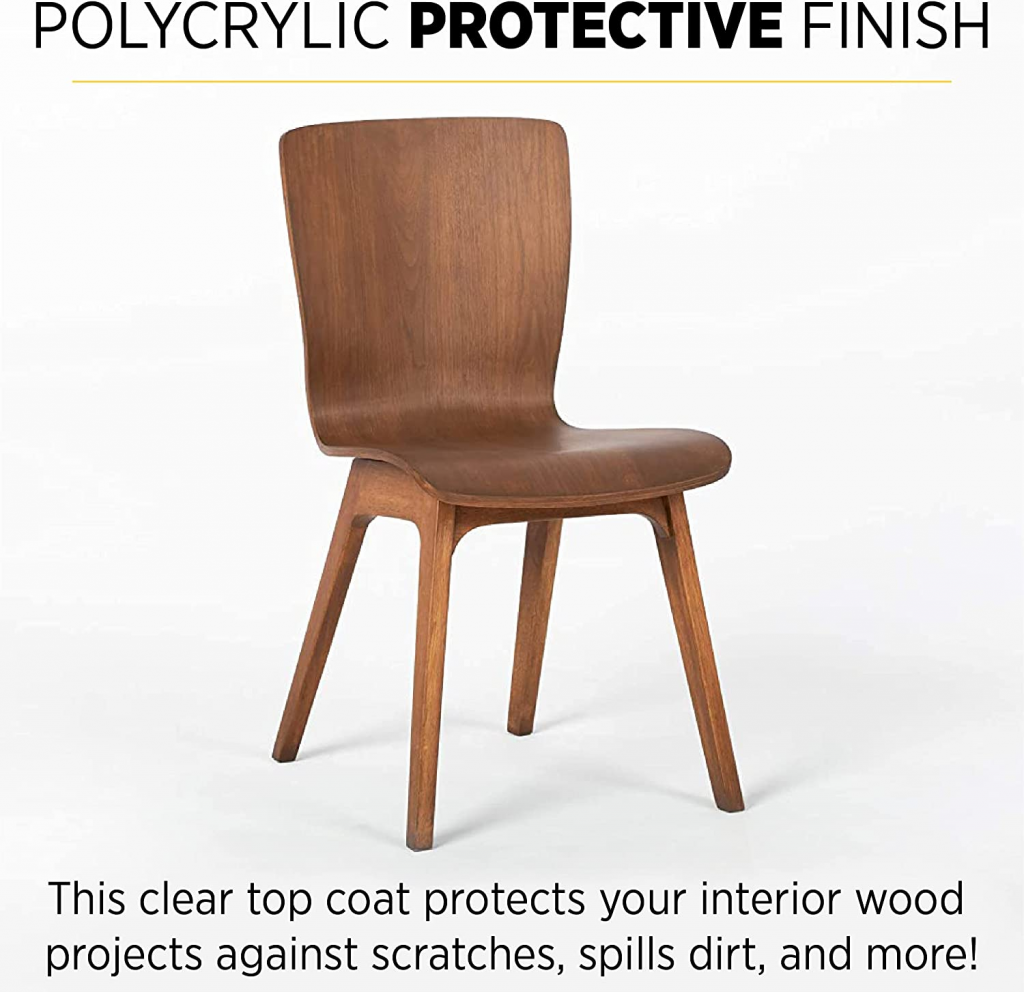
Is Polyurethane Toxic after It Dries?
With the beautiful and lasting sheen that polyurethane leaves on hardwood flooring, you may not realize its toxicity. The fumes that circulate during the application of polyurethane are usually toxic and can lead to irritation of the eyes, skin, and lungs. Besides, it triggers respiratory issues and can even cause brain damage.
Generally, experts deem polyurethane finish safe once it has spent days curing completely. The volatile organic compounds (VOCs) and isocyanates that polyurethane emits are what make it toxic. It is best to use a poly finish with care. Wear your gloves and goggles to avoid contact with the eye or skin.
Water-Based Polyurethane for Floors
Water-based polyurethane finishes use water as the base that carries the polyurethane. Its production involves mixing synthetic resins, plasticizers, and a water base. Despite its milky appearance, water-based polyurethane dries into a transparent film. The application of water-based polyurethane happens fast because they dry rapidly, allowing the application of more coats in lesser time.
Water-based poly is not thick, so a formula container can cover a wide surface area in one sweeping motion. A water-based poly finish is also pretty easy to finish. So, with warm water and rags, you can clean up excess water-based poly from your project.
Advantages of Water-based Polyurethane on Floor
- Produces little odor
- Easy to clean with water
- Non-yellowing
- Low VOCs
- Low sheens
- Rapid dry and cure time
- Non-flammable
Disadvantages of Water-based Polyurethane on Floor
- Low durability against scratches
- Require more coats for a hard shell
- Expensive
- Not suitable for all climates
Oil-Based Polyurethane for Floors
Generally, oil-based polyurethane finish is the type of finish that requires fewer poly coats due to its high density. It builds a thicker coating on a wood surface and will stay permanently on wood surfaces for a long time. However, oil-based poly thins and evens out on your wood when applied.
It features high odor and toxic levels, producing a relatively strong and unpleasant smell. With a relatively long drying time, oil-based poly can take 10-12 hours before it dries to touch. While enhancing the natural beauty of your floor, oil-based will leave rich, deep amber colors on your projects.
Advantages of Oil-based Polyurethane on Floor
- Less expensive than a water-based finish
- Doesn’t need much time to maintain
- Provides protective finish
- Offers an amber glow
- Thick finish and so requires fewer poly coats
Disadvantages of Oil-based Polyurethane on Floor
- Takes a longer time to dry
- Contains a high level of volatile organic compounds (VOCs)
- Not as versatile
- Not suitable for a wide range of surfaces
Water vs Oil-Based Polyurethane for Floors
Appearance
Water-based finishes usually have a dry clear appearance. The polyurethane will maintain its clear look for as long as the hardwood floor still exists. While the oil-based polyurethane has a dark appearance, which gives it a rich color. This dark color tends to continue with the oil-based polyurethane floor.

Dry Time
Oil-based finishes are known to dry throughout the night, so the following number of coats will be applied the next day. While for the water-based floor finishes, you can recoat the same day to reduce the length of days needed to conclude the woodwork.
Read More >> How Long Does Polyurethane Take To Dry?
Number of Coats
Typically, water-based polyurethane is a dilute product. You will need at least three coats of the product to get the desired effect on your project. However, a maximum of two coats of oil-based polyurethane will do an excellent job. Oil-based is generally thicker than water-based and so won’t need more coats.
Read More >> How Many Coats Of Polyurethane Is Right?
Durable
Water-based polyurethane is durable, just like oil-based. If carefully applied, water-based polyurethane will last for a long time. Oil-based polyurethane has the same features but is more durable than its water-based counterparts.
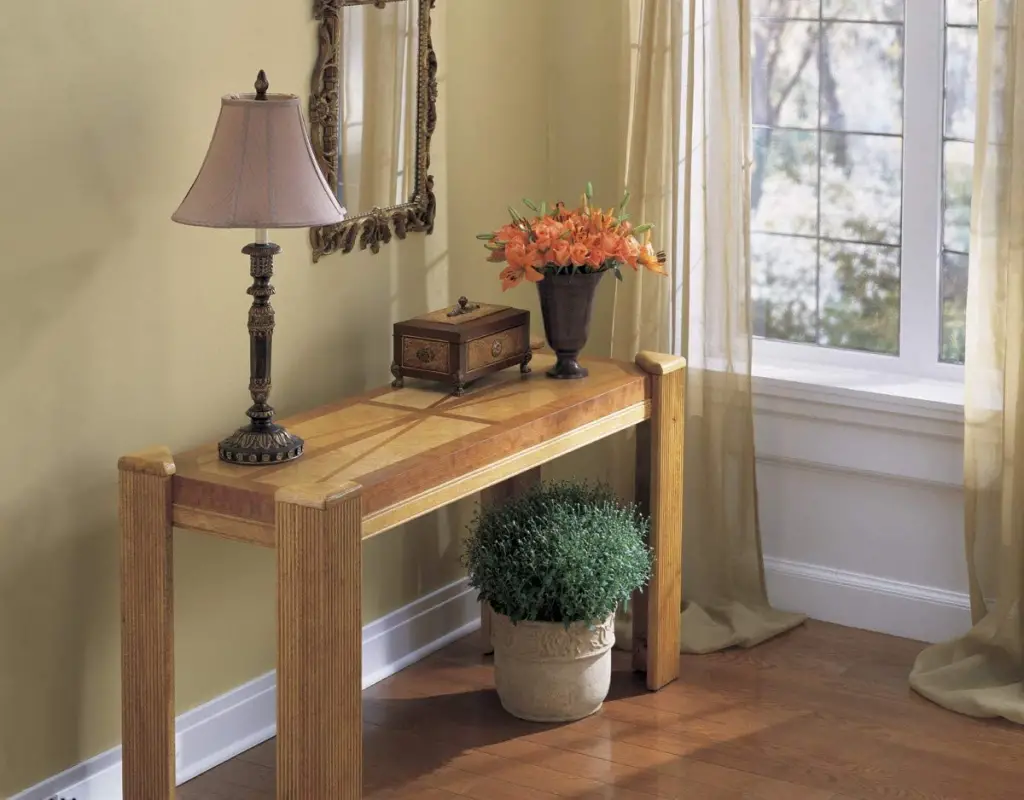
Read More >> Water-Based Vs. Oil-Based Polyurethane Finish: Which Is Better On Wood?
Types of Polyurethane Finish on Floors
Matte
Matte finish has substantial protection against scratches and dirt, even as scuffs are not clearly visible on the floor. This type of polyurethane floor finish is appealing to most users simply because it does not reflect an intense light as a glossy appearance.
Satin
Satin is a unique floor finish with good sparkle, yet not too shiny and does not easily tear off. It can maintain its glam appearance for a long time without revealing scratches.
Semi-gloss
Semi-gloss is positioned between shine and satin. The luster feature of the gloss brings gives the floor a more attractive look. Still, it requires regular maintenance to keep the floors looking new and beautiful.
High Gloss
Like its name, the high gloss has the most sparkle and is not always used on busy floors. This polyurethane finish is typically used on reserved and less trafficked floor areas.
Read More >> Satin Vs. Semi-Gloss Polyurethane Finish: What’s The Difference?
Do You Have to Sand between Coats of Polyurethane on Floors?
No. You don’t have to sand between coats of polyurethane on floors as long as you apply the next coat on the wood surface in the next twelve hours.
You only recommend that you sand between coats when applying aerosol polyurethane on hardwood floors. Nevertheless, you do not necessarily need to sand between coats when working with water-based polyurethane; but this depends on the make of the product you purchased.
Read More >> Do You Have To Sand Polyurethane Between Coats?
How to Apply Polyurethane for Floors Step by Step?
While wood flooring is beautiful, it gets damaged easily. Polyurethane finishing is a vital part of the flooring process. It provides solid, waterproof, and lasting protection for wood floors. Follow the steps in this guide as we walk you through the process of applying polyurethane to your flooring.
Tools You Need
- Oil-based polyurethane/Water-based polyurethane
- Floor finish applicator with pole
- Bristle brush
- Sander machine
- Mixing stick
- Fine-grit sandpaper
- Vacuum machine
- Mineral spirits/White vinegar
- Can
- Clean rags
Before you begin, do the following:
Safety Considerations:
Safety gear: Respirator/eye protection, Work gloves/ knee pad, Shoe covers/ old socks
- Wear protective gear: Use the correct protective equipment before applying polyurethane. Wear a respirator, work gloves, safety glasses, and disposable boot covers. Read instructions carefully multiple times.
- Ventilate the workspace: The fumes released by polyurethane are dangerous. Ensuring proper ventilation in the room is vital, as you may experience light-headedness and headache.
Steps for Applying Polyurethane on Floors
Here are the steps on how to apply polyurethane to the floors:
Step 1: Prepare the Floor
Like with all wood finishing processes, you need to sand down the surface of your wood floor. Sanding provides the new finish with a smooth surface that will help it adhere to the wood. Using an orbital sander, remove the existing finish to reveal a smooth and even wood surface ready for new finishing.
Step 2: Vacuum the Floor
Next, use your vacuum cleaner to clean the dust and dirt from sanding. Ensure that your cleaning is thorough and that all corners are touched, allowing for a neat finishing. After vacuuming, use white vinegar or mineral spirit to wipe the floor surface. Henceforth, walk with clean socks or covered shoes over the floor.
Step 3: Mix the Polyurethane
Don your safety gear as it’s time to get to work. Carefully open the can of polyurethane and mix properly before application. Turn the liquid into a big can and use a mixing stick to stir for the instructed period.
Step 4: Apply the Polyurethane
Apply the first coat with care. Dip your applicator in the polyurethane and begin from a corner with overlying, long strokes to get an even coat. Look out for drops or places you may have missed and fix them after the first coat. You can then use a bristle brush to apply the finish to the corners, ensuring it blends in properly.
Step 5: Apply the other Coats
Allow the coat to dry as recommended by the manufacturer on the instructions. After the surface dries up, sand the floor lightly with fine sandpaper (220-grit). Clean the floor with your vacuum and mineral spirit or white vinegar. Apply the second coat of polyurethane finish and wait for the advised time once again. Rinse and repeat until the final coat is applied.
Step 6: Clean the Floor
Aftercare is necessary once you’ve successfully applied the finishing to your flooring. Use the appropriate cleaner on your floor. To prevent stains from discoloring your flooring, wipe all spills immediately.
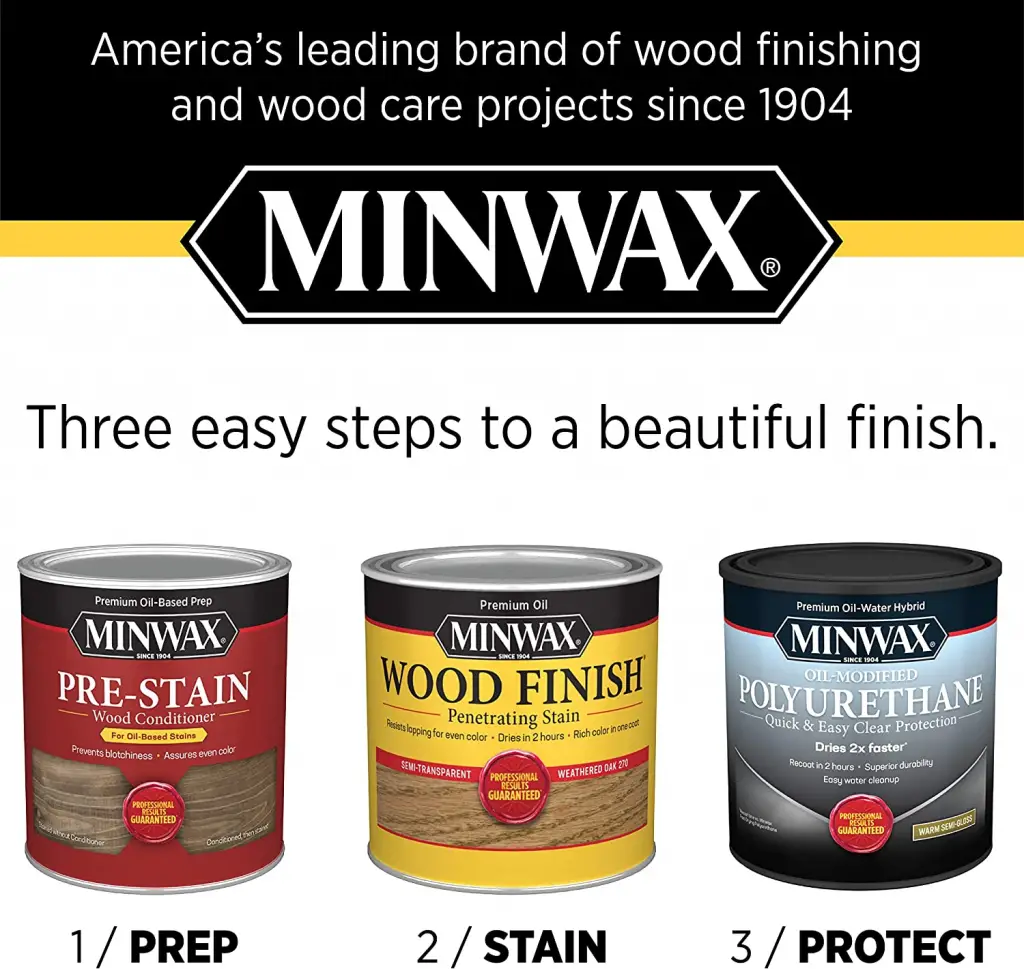
What to Consider Before Choosing Polyurethane for Floors
Determining what finishing you should use on your hardwood floors is essential. A popular product is polyurethane finishing. Outlined below are factors to consider before choosing polyurethane for your flooring.
Types of Polyurethane
Polyurethane finish is available in two major types:
- Water-based polyurethane
- Oil-based polyurethane
Although both types of polyurethane perform the same function, specific differences may sway your choice. You may pick your polyurethane finishing based on:
- Satin – The most commonly chosen finish, statin gleams without being too shiny while hiding scratches and wear.
- Matte – Another popular choice, matte possesses little glimmer and perfectly hides grime, scuffs, and scratches.
- Semi-gloss – Possessing more shine than the satin finish but with less sheen than the high gloss, this is the shiniest most people will go. Its glimmer displays the beauty of the hardwood but requires constant care to stay beautiful.
- High gloss – With the most luster, the application of high gloss finishing is common on floors with minimal traffic. Maintenance is very high as this finishing shows all scratches, grime, and scuffs.
Color & Sheen
Depending on your polyurethane finish, your options may provide varying colors and sheen. Oil-based polyurethane gives an amber tint which turns more yellow with age. In contrast, water-based polyurethane dries clear and does not yellow.
Durable
While exploring your options, consider the amount of traffic the flooring is likely to get because this will affect the durability of the finishing applied. In an area with lots of traffic, consider using an oil-based polyurethane finish as it lasts longer. In rooms with lesser traffic, using a water-based polyurethane will suffice.
Dry Time
Another factor to consider is how quickly you need the surface ready for use. If you need a finish with a quick dry time, go for the water-based polyurethane. You can apply a second coat of water-based polyurethane in 2 hours compared to oil-based polyurethane, which needs anywhere from 4 to 24 hours. Water-based polyurethane also cures in about two days after the last coat, while oil-based polyurethane needs a couple of weeks to cure perfectly.
Odor & Toxicity
You may have realized that you will be spending hours applying the finishing. The smell will likely be of concern to you; the same goes for the toxicity. The odor and VOC (volatile organic compound) emitted by water-based polyurethane are lesser than oil-based polyurethane. These factors make it safer for you, particularly in a room with little ventilation and the environment.

Easy to Use
The application of water-based polyurethane is less demanding than the oil-based one. When applying a water-based polyurethane finish, most manufacturers advise that there’s no need to sand in-between coats. This saves energy and time. Using water-based polyurethane may be the best option if you are a beginner and this is a DIY project.

Budget
Cost is evidently an important aspect to consider before settling on the finish you want to use. The cost of the finish you use is dependent on what look you want. Oil-based polyurethanes are considerably cheaper than their water-based counterparts. Also, bear in mind that the floor span will also influence the cost.
Best Water-Based Polyurethane for Floors
Let’s take a look at a quick preview of the best water-based polyurethane for floors:
- Minwax Water-Based, Oil-Modified Polyurethane Protective Wood Finish, Clear Satin
- Deft Interior Exterior Water-Based Polyurethane Finish Gloss, Quart
- RUST-OLEUM FBA 230031 Varathane Gallon Gloss Waterborne Diamond Floor Finish
- Bona Mega Semi-Gloss, Polyurethane Finish
- RUST-OLEUM 298273 Varathane Vara Gallon Semi-Gloss Water Based Finish
- General Finishes High-Performance Water Based Topcoat, 1 Pint, Satin
- Minwax 13333 Clear Polycrylic Water-Based Protective Finish Satin
Minwax Water-Based, Oil-Modified Polyurethane Protective Wood Finish, Clear Satin
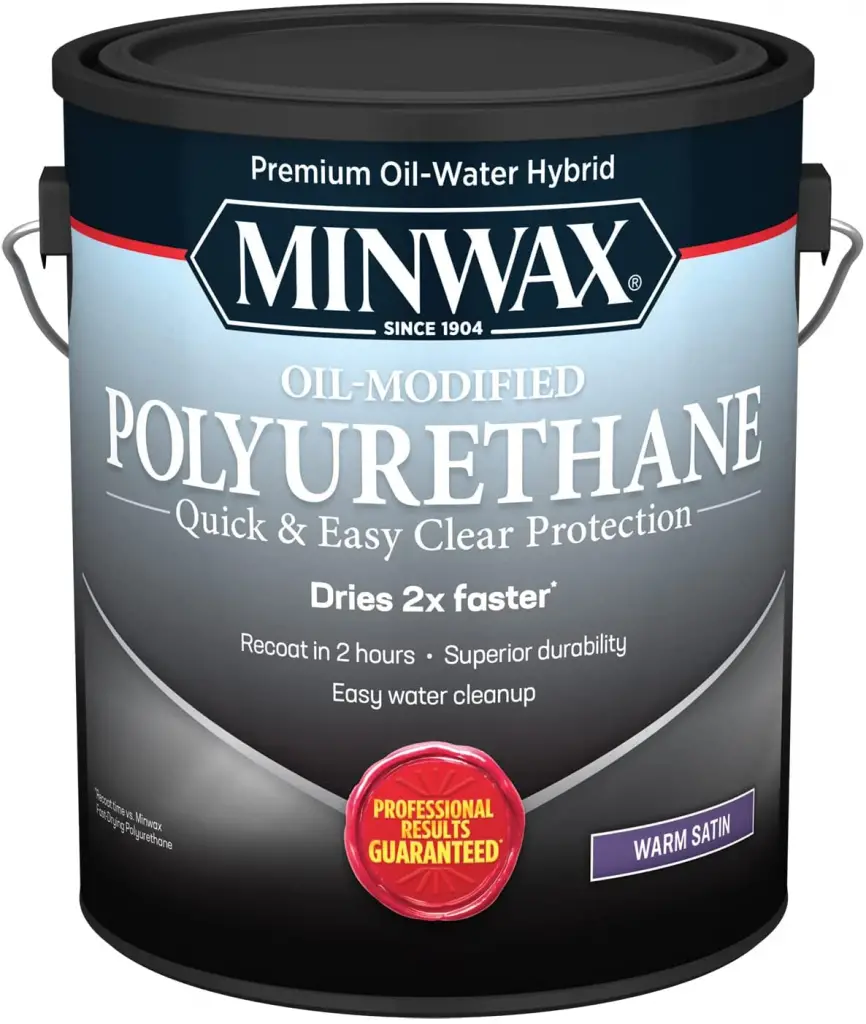
Minwax comes as one of the leading water-based polyurethane formulas for your wood, floors, cabinets, furniture, and doors. This perfect oil-modified protective finish cleans up easily, leaving behind a high sheen of a satin finish.
This kit will provide protection and add fantastic beauty to your project. It works on finished and unfinished wood and is available on a wide range of sheens. This ultra-fast drying formula will confer an on-trend look on your product. You can clean it up with warm water. The icing on the cake is the low odor level of this finish.
Pros
- Cleans up easily with water
- Highly durable and long-lasting
- Provides quality protection
- Perfect for floors, cabinets, doors, and wood
Cons
- Can drip and run
Deft Interior Exterior Water-Based Polyurethane Finish Gloss, Quart

Suppose you’re keen on finishing your hardwood floors with a high-quality poly formula. In that case, the Deft Interior fast-drying product is a suitable kit. It leaves a clear satin finish on your wood while protecting it to ensure it doesn’t flake or chip.
This product offers quality protection for interior and exterior surfaces of different projects, including wood, floors, furniture, and cabinets. It looks pretty good on both finished and unfinished surfaces. While it dries super-fast, this product will offer a durable and long-lasting finish on your wood.
What’s more, the Deft Interior allows you to recoat your project barely after 4-6 hours of the first coat. It also comes in a wide variety of sheens.
Pros
- Allows short time for recoating
- Durable and long-lasting
- Dries fast and easy to clean
- Perfect for finished and unfinished wood
Cons
- Can only be applied with a natural or foam brush
RUST-OLEUM FBA 230031 Varathane Gallon Gloss Waterborne Diamond Floor Finish

The Rust-Oleum is an oil-based poly paint that offers quality protection to the interior surfaces of various projects, including doors, woods, trims, cabinets, and furniture.
The formula offers excellent protective durability and allows the project to look elegant with a smoother and more even finish. Although it dries to touch in 2 hours, the Rust-Oleum Poly is one of the fastest-drying oil-based products.
Its 150 square feet coverage is incredible. You can add the second coat to the surface in 4-6 hours. With this product, you’re sure of outstanding resistance to scratch and stain. Your surface won’t flake or chip, yet it will maintain its natural and classic look for a long time.
Pros
- Highly resistant to scratch and stain
- Dries to touch in 2 hours
- Long-lasting and durable
- Perfect on wood, doors, floors, trims, and furniture
Cons
- Slow drying time
- Can be costly
Bona Mega Semi-Gloss, Polyurethane Finish
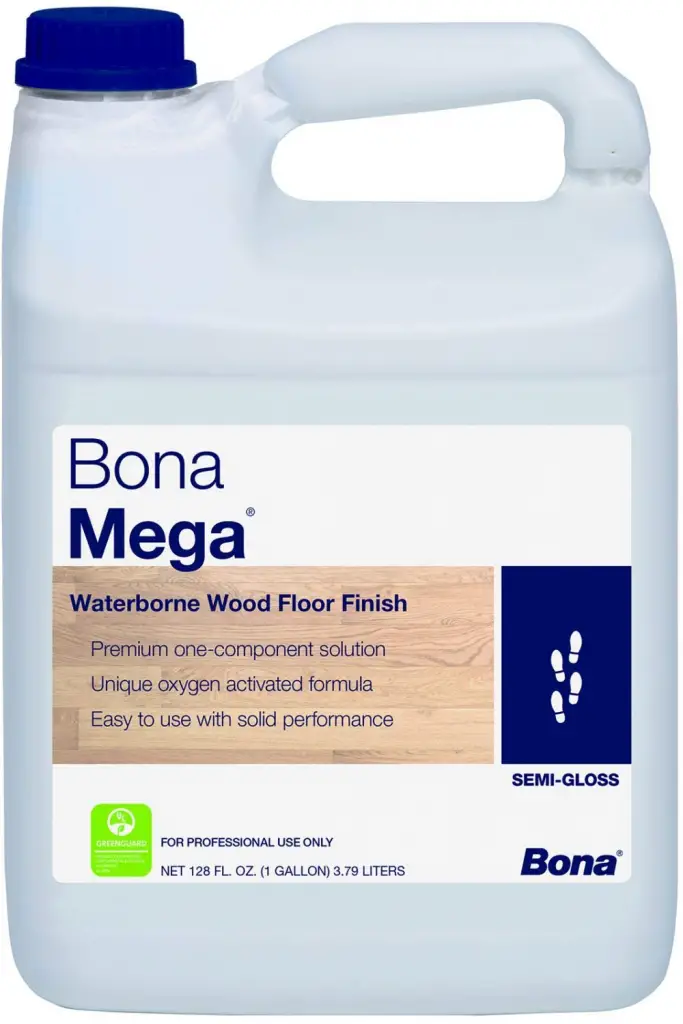
The Bona Mega Semi-Gloss Finish is suitable for use on busy floors in residential or commercial areas. It contains a natural wood color which gives the floor a fantastic appearance. Also, the gallon is designed for easy use and fast spray to provide a beautiful and smooth finish.
Compared to other water-based stain types, the Bona mega polyurethane has a slow drying time of 2 to 3 hours. Yet, the formula has a proven track record for high performance and value-driven standards. When it comes to aesthetics and durability, this is the kit to go for.
This solution has low volatile organic compounds, making it less toxic.
Pros
- Low odor and less toxic
- Cleanse up easily
- Perfect for commercial or residential
- Easy to use
Cons
- Quite pricey
- Relatively long drying time
RUST-OLEUM 298273 Varathane Vara Gallon Semi-Gloss Water-Based Finish
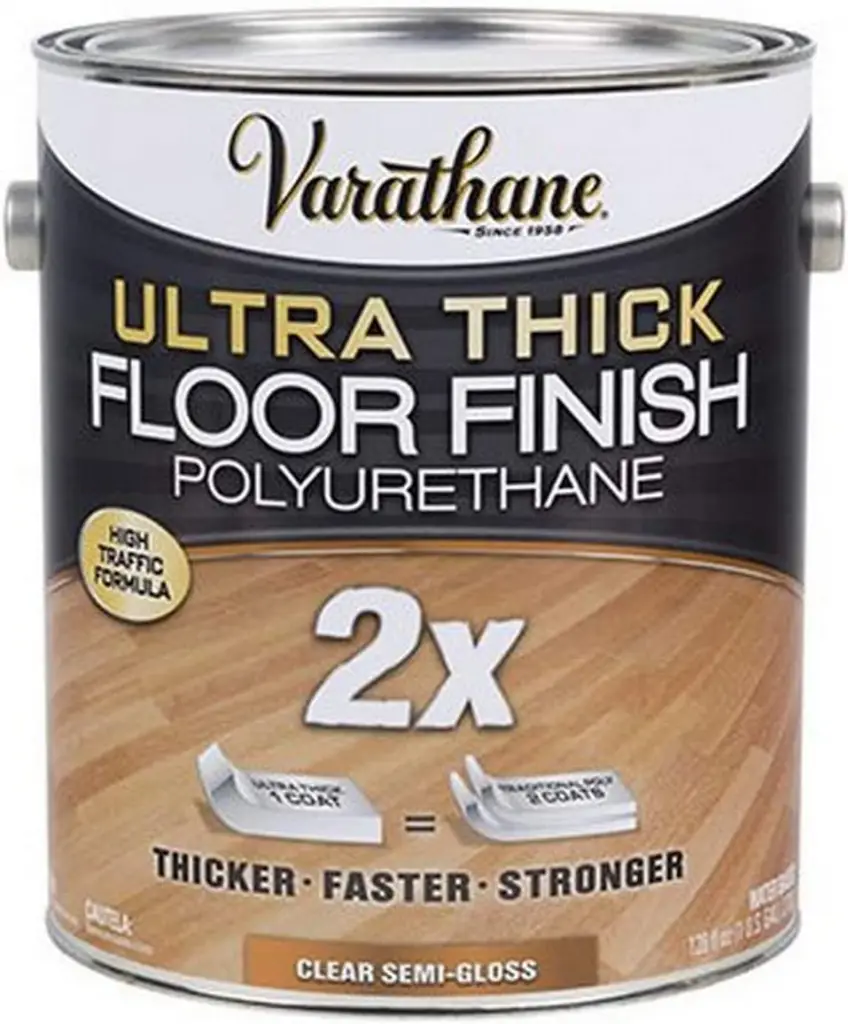
Using an Ultra thick waterborne floor finish is particularly blended to offer an easy application for quick project completion. Its self-leveling technology allows coats to be applied twice to finish a project, rather than three to four coats.
The component mixture in Rust-Oleum provides strong resistance against scratches and stains. So, you can easily clean it up with soap and water. It’s suitable for all interior wood floors and surfaces such as furniture and doors.
The product is straightforward with a brush, roller, and sprayer. It has a versatile property that makes it the best pick for various uses.
Pros
- Easy to clean with soap and water
- Excellent semi-gloss finish
- Resistant to scratches and chipping
- Used for interior and exterior projects
Cons
- Can be used with only a select brush size
General Finishes High-Performance Water Based Topcoat, 1 Pint, Satin

This high-performance water-based topcoat is perceived to be one of the most durable polyurethane finishes available today. It contains a list of appealing features alongside a poly-acrylic mixture.
Also, it comes with a UV stabilizer that protects against any wearing and tearing when exposed to sunlight and strong protection against discoloration. Given its durable feature, it is recommended to be used on floors.
You can be sure of quality protection to your surface. Although a dry time of 1-to hour may be relatively slow, you can easily clean up the formula with soap and water. It will also work well on interior products while retaining its tough and durable poly coating.
Pros
- Spreads evenly on wood floor
- Fast dry with 3 coats
Cons
- Less glossy
- Interior use only
- Light unnoticeable yellowing
Minwax 13333 Clear Polycrylic Water-Based Protective Finish Satin
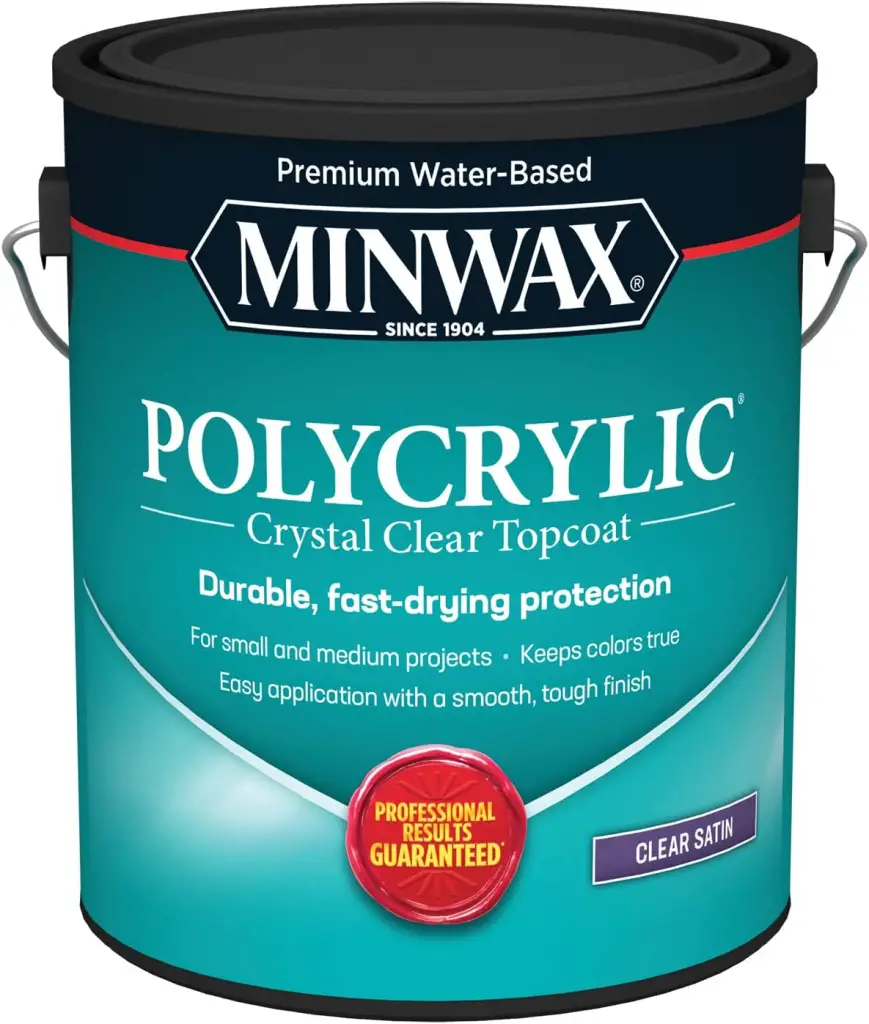
Minwax Polycrylic satin finish effectively protects and gives your interior woodwork an appealing look. It is suitable for use over all Minwax polyurethanes, whether oil-based or water-based stains.
Its fast-drying feature allows for recoating after two hours. The Minwax protective satin finish is suitable for woodworks such as cabinets, furniture, and doors. In addition, it has substantial protection against surface scratches, dirt, and spills. With the Minwax water-based protective finish, you are sure of natural beauty on your wood project.
What is more, it dries between 2 hours, making it one of the relatively fast-drying water-based solutions you can find on the market. It is easy to clean with soap and water and won’t mess up your project workspace. It doesn’t drip or run.
Pros
- Low odor.
- Protects all wood species.
- Easy clean up with soap and water.
- Protects against abrasion.
Cons
- Quantity too small
Best Oil-Based Polyurethane for Hardwood Floors
Let’s take a look at a quick preview of the best Oil-based polyurethane for floors:
- Minwax Fast-Drying Polyurethane Protective Wood Finish, Clear Satin, 1 Quart
- Rust-Oleum 9141H Oil-Based Ultimate Polyurethane, Quart, Satin Finish
- ZAR 33912 Oil Based Polyurethane Wood Finish, QT, Clear
- RUST-OLEUM 130031 Varathane Gloss Oil Base Premium Polyurethane Floor Finish
- Watco 68041 Wipe-On Polyurethane Finish, Quart, Clear Gloss
- Old Masters 3576 Polyurethane Oil-Based Finish Gloss, 1 Quart, Clear
- General Finishes Arm-R-Seal Oil Based Topcoat, 1 Quart, Gloss
Minwax Fast-Drying Polyurethane Protective Wood Finish, Clear Satin, 1 Quart
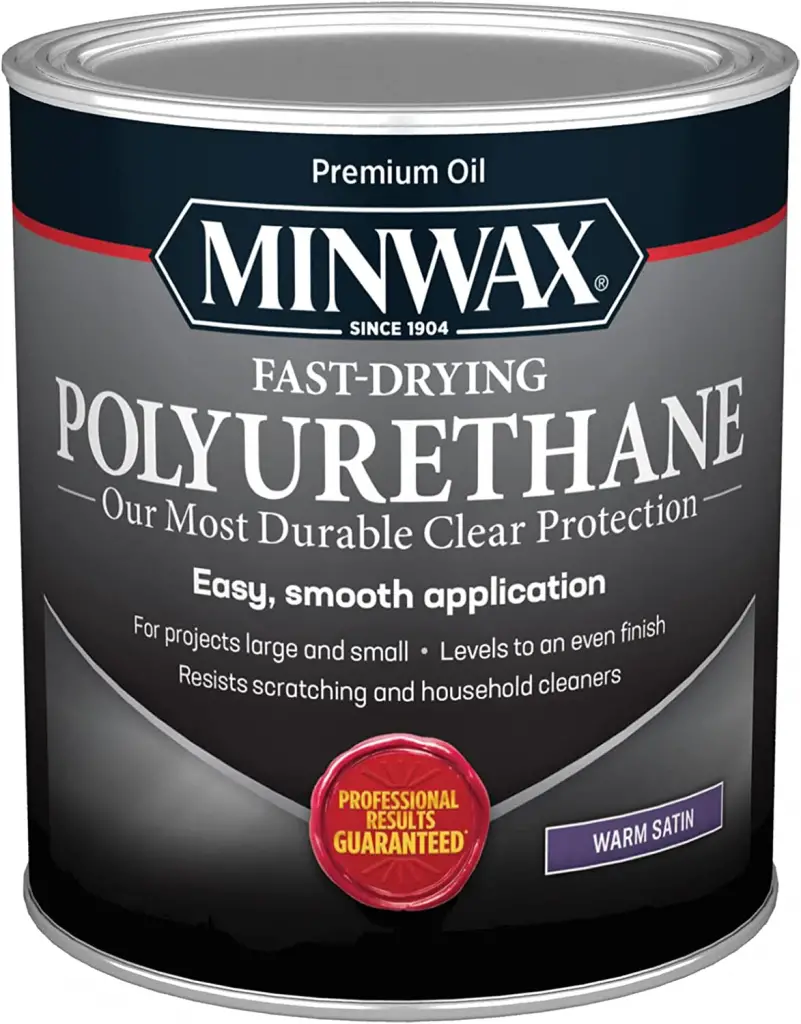
Minwax-Fast-Drying polyurethane finish is one of the fastest drying oil-based polyurethane products available. Minwax is perfect for projects with a short timeline. Unlike most other oil-based polyurethane products, applying the second coat can happen between three to four hours.
Minwax poly is easy to clean and tolerates a wide range of conditions. This solution is available in gloss, semi-gloss, and statin. You can apply it with your natural brush or synthetic pad applicator to get a beautiful finish.
This is a go-to kit for a satin sheen. You can recoat the poly stain after 4-6 hours. However, it has a super-fast drying time, giving it a competitive edge over many other oil-based formulas. This is a go-to kit for a satin sheen.
Pros
- No sanding between coats
- No need to stir constantly due to its anti-settling formula
- Extremely durable
- Optimized drying technology
Cons
- Using a roller for application results in air bubbles
- Expensive
Rust-Oleum 9141H Oil-Based Ultimate Polyurethane, Quart, Satin Finish
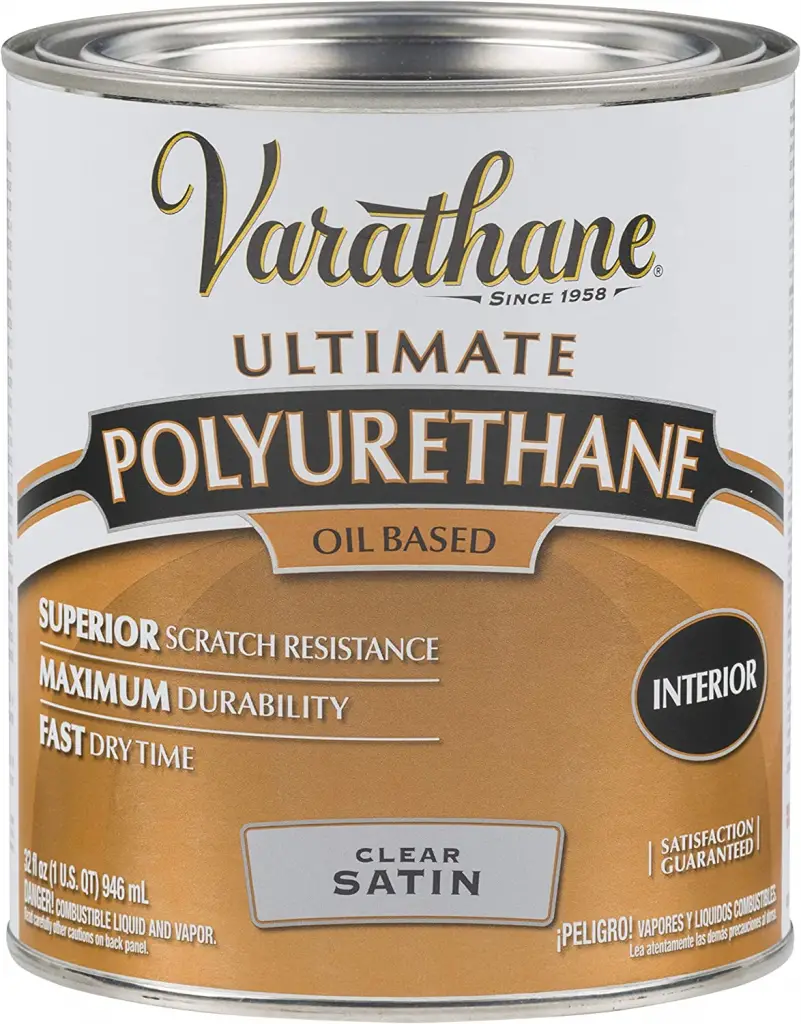
Rust-oleum 9141H is oil-based polyurethane that provides a warm statin finish to your hardwood flooring after its application. Possessing a clear finish than other oil-based polyurethane in its category, Rust-Oleum 9141H matures into a deeper hue over time.
Rust-oleum provides a protective layer over wooden surfaces and is perfect for use in interior spaces. Use it on wood with color as its slight golden sheen matures with age.
This guy genuinely reflects what Rust-Oleum stands for. It protects interior wood surfaces, including trim, doors, cabinets, and furniture. It is a durable and scratch-resistant solution that allows for a smooth and even finish. It dries to touch in about 2 hours, making it a great pick among fast-drying poly finishes.
Pros
- You can recoat in 4 hours
- Can apply the second coat in four hours
- Very durable and covers 150 sq. ft.
- Stain and abrasion-resistant
Cons
- Tendency to leave brush marks and patterned drying
- Develops a gummy consistency easily
ZAR 33912 Oil-Based Polyurethane Wood Finish, QT, Clear
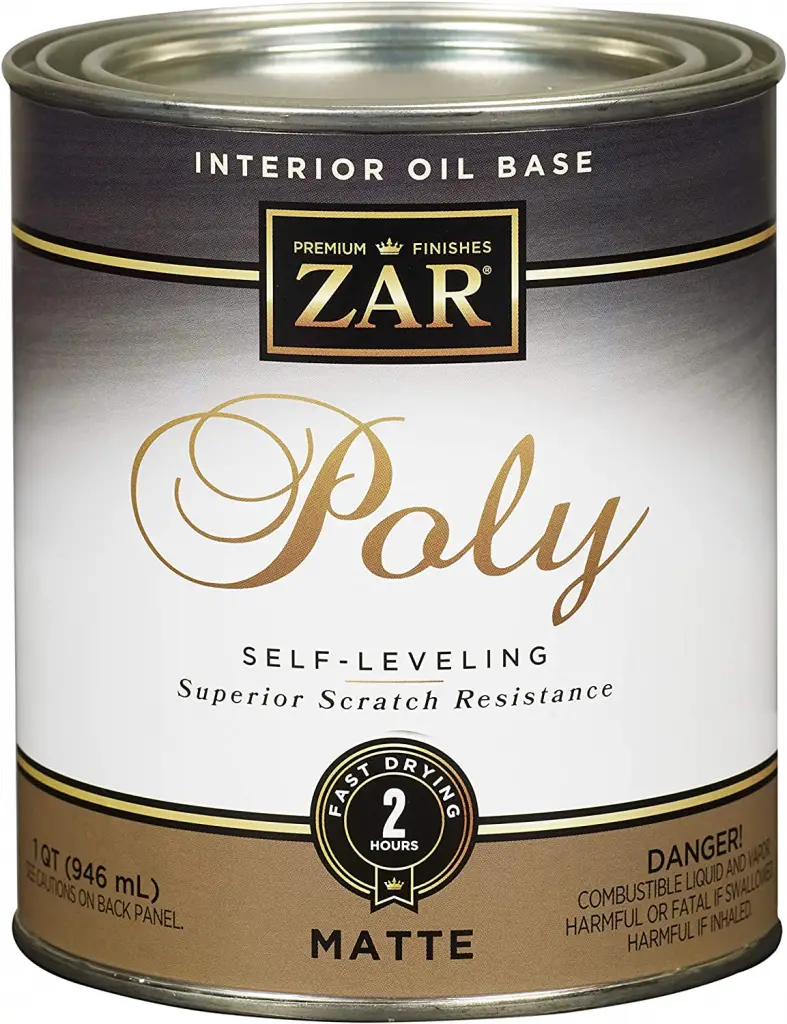
The Zar is another oil-based polyurethane worthy of mention, thanks to its smooth finish and more evenness on raw wood. In as little as two hours after application, you see a dry surface lacking traces of brush marks. Just three coats of Zar polyurethane provide a protective layer over your floor.
The Zar 33912 is statin-resistant and does not develop streaks when liquids of any nature spill on it. This smooth, self-leveling product is resistant to tough abrasion and won’t flake. These traits make it ideal for areas with high traffic. Although limited to interior projects, this formula will produce an amazingly durable chip resistance.
Pros
- Resistant to abrasions
- Formulated to settle into a level and smooth finish
- Suitable for beginners
- It is simple and fast to use
Cons
- Fragile can
- Only suitable interior spaces
RUST-OLEUM 130031 Varathane Gloss Oil Base Premium Polyurethane Floor Finish
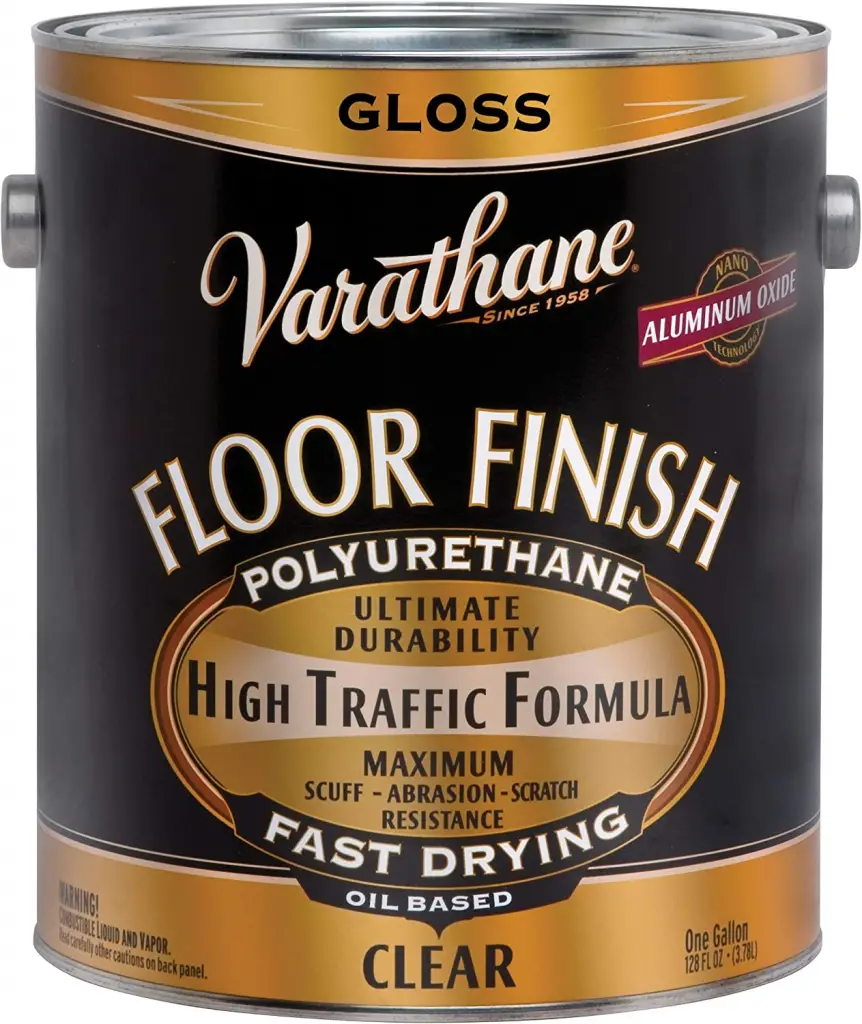
The Rust-Oleum 130031 utilizes a patent Aluminum Oxide NanoTech to create an abrasion-resistant layer over your hardwood flooring. This oil-based polyurethane also possesses resistance to stains and can withstand spills from household chemicals. It is perfect for rooms with high traffic due to its durability.
You can apply the Rust-Oleum on bare and painted hardwood floors. It comes in semi-gloss, gloss, satin, and matte. According to the manufacturer, use the product without mixing it with a thinner.
Are you are looking for a warm, golden glow on your wood surfaces, you have to opt for the Rust-Oleum 130031. It is an excellent poly finish for a classic clear gloss surface. It is a perfect self-leveling product that leaves no brush strokes on your wood surface.
Pros
- A cheaper choice than products of similar features
- Possesses a warm golden sheen
- Self-leveling and smoothening
- Highly resistant to scratch and abrasion
Cons
- Dries slowly
- Applying it with a roller causes bubbles to form
Watco 68041 Wipe-On Polyurethane Finish, Quart, Clear Gloss
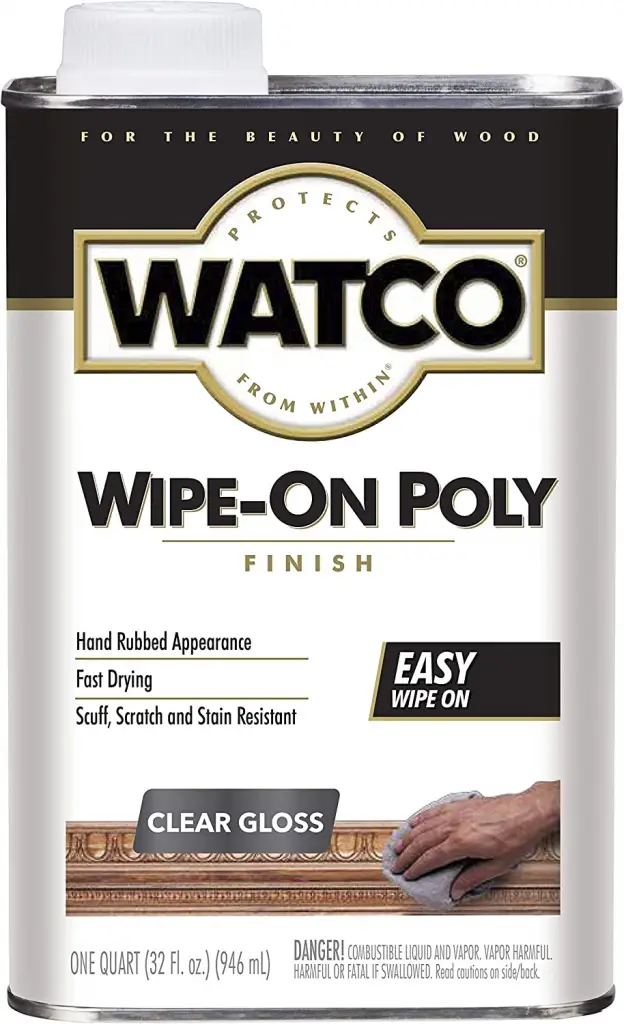
Watco Wipe-On polyurethane occupies the unique position of being hand-applied to hardwood surfaces. This makes this oil-based polyurethane ideal for use in spaces that are hard to reach with your brush or roller.
Simply dip your chosen piece of clean cloth in Watco poly and wipe it on the spot. Wipe-on poly provides a beautiful and glossy clarity after application, showing off the beauty of the wood grains.
Suppose your project comes in contact with household chemicals or water. In that case, this poly finish will protect it from flaking, scratching, chipping, or abrading. It leaves a gloss finish on your surface, making the application smooth and even.
Pros
- Easy application using a brush, pad, or cloth to apply
- Dries fast
- Stain-resistant, water and household chemicals tolerant
Cons
- Not resistant to scratch from sharp objects
- Not suited for areas with high traffic
Old Masters 3576 Polyurethane Oil-Based Finish Gloss, 1 Quart, Clear

Old Masters 3576 oil-based polyurethane is a great product that gives your hardwood floor a clear glossy finish. This polyurethane is very durable for surfaces that experience high traffic, protecting your floor from marring.
Following the manufacturer’s instructions, apply this oil-based polyurethane using a lambswool applicator or a natural bristle brush. Stir instead of shaking to prevent air bubbles from forming.
If you want to paint your household supplies and wood stains, the Old Masters comes in handy for this purpose, which won’t flake or chip. Although it contains a high level of VOC –about 450 g/L- you can subside its skin and eye irritation effect with protective gloves and masks.
Pros
- Resistant to abrasions, scuffs, and a host of liquids
- Durable and lightweight
- Dries to touch in three hours
- Allows recoating after six hours
Cons
- VOCs of 450 g/L
- Not a popular oil-based option
General Finishes Arm-R-Seal Oil Based Topcoat, 1 Quart, Gloss

Arm-R-Seal topcoats are high-quality urethane resin oil-based topcoats. This product’s extreme durability gives your hardwood the perfect natural finish you desire. They last long and can take the wear and tear of high traffic.
Due to its unique formulation, you can apply Arm-R-Seal with cotton clothing or a foam brush. This ensures that the topcoat goes on evenly to achieve a clear, glossy look. Satin, semi-gloss, and gloss are the options of Arm-R-Seal available.
The Arm-R-Seal comes atop many of its counterparts when it comes to durability and longevity. It doesn’t flake or lose its sheen regardless of the number of years it stays on your project. It is a budget-friendly option on the list
Pros
- Little odor
- Deeply penetrates the wood
- It leaves behind a beautiful sheen
- No plastic look of other polyurethane finishing
Cons
- Tendency to leave streaks
- Can form bubbles during application
- Slow dry time
How to Care for Polyurethane Wood Floors?
Observe the following to care for your polyurethane-finished floors:
- Frequent vacuuming to remove scratch-causing dirt and damp-mopping once in a while.
- Follow the cleaning instructions given by the manufacturer or use a mild soap or detergent to clean.
- Use doormats to reduce grit.
- Avoid wearing shoes that may leave marks or dents on the floor.
- Never wet-mop.
- Wipe up spills immediately.
- Use felt or rubber protectors for furniture legs. Do not drag your furniture over the floor.
Alternatives to Polyurethane
The truth is that polyurethane is not great for your safety and health. It can cause a lot of health risks, including skin and eye irritation, inflammation, asthma, and eco-toxicity. There are other respiratory hazards that excessive exposure to poly can cause. Due to its popularity, however, poly is what most people pick. There are other non-toxic alternatives to polyurethane. They function in a similar capacity as polyurethane.
- Varnish
- Shellac
- Danish oil
- Lacquer
- Tung oil
- Linseed oil
- Candelilla wax
Related Post >> Varnish Vs. Polyurethane Vs. Lacquer Vs. Shellac: What’s The Difference?
Final Words: What is the best way to apply polyurethane to a floor?
Now, you have it. We have highlighted the best polyurethane products for floors. We have also looked at the best method to apply poly to the floor. You can use a paintbrush, a sprayer, or a roller to achieve a neatly polished floor. What’s crucial is that you shouldn’t skip any of the steps when applying poly.
If you don’t feel comfortable using poly, we have other alternatives. They will serve the same purpose as poly. Nonetheless, poly has become the most popular among many woodworkers and painters.

My name is Mark, and I am a software engineer and the founder of OnWoodWorkingArt.
I grew up with a passion for woodworking and now have my woodworking studio with a group of like-minded friends who love to create woodworking. My dream is to have a more extensive workshop and be able to make woodworking my main business.